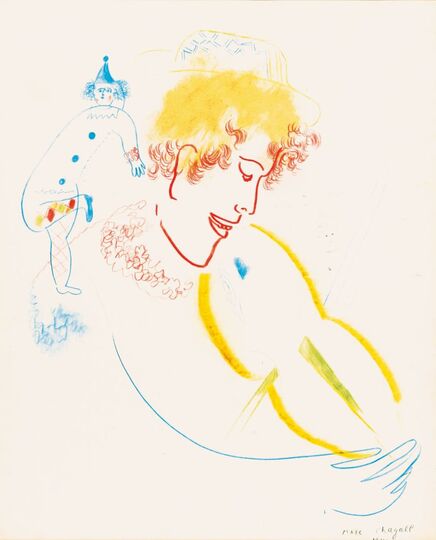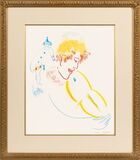Violiniste au Chapeau
Marc Chagall (Witebsk 1887 - St.-Paul-de-Vence 1985)

Lot-No. 258
Proceeds : 37.900 €
Coloured pencil, pastel and ink. 54.5 x 44.5 cm (21.5 x 17.5 in.). Lo. ri. sign. and dat. Marc Chagall 1940, on the reverse French customs stamp, matted and framed under glass. - Like other good artists, Chagall mastered the art of omission. With a few confident strokes in the primary colours red, yellow and blue, he establishes the basic framework of the composition. Colourful additions in green and orange contribute to the balance of the colouring, fine internal drawings provide life and movement. Cheerfulness, music, dance, circus - the recurring themes of Chagall's great affirmation of life - also characterise this motif from 1940. It gives no hint of the difficult times in which the artist created it. In 1937, many of his works were confiscated in Germany as 'degenerate'. Because of the growing anti-Semitism in France and the increasing pressure of the German persecution of the Jews, Chagall had retreated to the south of his adopted country, France, only one year before creating this work. When he was no longer safe there either, he emigrated to the USA in 1941. Nevertheless - Chagall's 'Violiniste au Chapeau' is smilingly absorbed in its music. The colours radiate warmth. The violinist and his companions, the dancing clown and the ballerina in the background, gather in a closed composition that expresses security through the wide arches of the violinist's arm, the clown's body and the hat. - Expertise: Jean-Louis Prat, Comité Marc Chagall, Paris 21. Juli 2014 - Provenance: Manichi Auctions, Tokio, 1. August 2014, lot 1186; private collection Japan; Christie's London, 28. February 2018, lot 221; since then private collection Hamburg - One of the most important artists of the 20th century, whose beginnings lay in Fauvism and who later found a distinctive lyrical-modern form of expression. C. attended private painting schools in St. Petersburg after failing to gain admission to the academy. With the help of a scholarship, he was able to move to Paris in 1910, where he soon found a connection to the avant-garde art scene and was able to take part in the customary exhibitions. During a visit to Russia, the First World War broke out and prevented C. from returning to Paris. He was unable to assert himself against Malevich as a cultural functionary of the Revolution and, after a stop in Berlin, he returned to France. Persecution of the Jews forced him into exile in New York in 1941-48, where he was honoured with a retrospective at MoMA. Back in France, he exhibited in many important European museums as well as at Documenta and received important public commissions. Mus.: New York (MoMA, Guggenheim Mus.), Paris (Centre Pompidou), London (Tate), Amsterdam (Stedelijk Mus.), Zurich (Kunsthaus), Chicago (Art Institute) a. others. Lit.: AKL, Mourlot/Sorlier: Chagall - Lithographe a. others.
Marc Chagall: Violiniste au Chapeau
Marc Chagall (Witebsk 1887 - St.-Paul-de-Vence 1985)
Violiniste au Chapeau
Lot-No. 258
Proceeds : 37.900 €
Coloured pencil, pastel and ink. 54.5 x 44.5 cm (21.5 x 17.5 in.). Lo. ri. sign. and dat. Marc Chagall 1940, on the reverse French customs stamp, matted and framed under glass. - Like other good artists, Chagall mastered the art of omission. With a few confident strokes in the primary colours red, yellow and blue, he establishes the basic framework of the composition. Colourful additions in green and orange contribute to the balance of the colouring, fine internal drawings provide life and movement. Cheerfulness, music, dance, circus - the recurring themes of Chagall's great affirmation of life - also characterise this motif from 1940. It gives no hint of the difficult times in which the artist created it. In 1937, many of his works were confiscated in Germany as 'degenerate'. Because of the growing anti-Semitism in France and the increasing pressure of the German persecution of the Jews, Chagall had retreated to the south of his adopted country, France, only one year before creating this work. When he was no longer safe there either, he emigrated to the USA in 1941. Nevertheless - Chagall's 'Violiniste au Chapeau' is smilingly absorbed in its music. The colours radiate warmth. The violinist and his companions, the dancing clown and the ballerina in the background, gather in a closed composition that expresses security through the wide arches of the violinist's arm, the clown's body and the hat. - Expertise: Jean-Louis Prat, Comité Marc Chagall, Paris 21. Juli 2014 - Provenance: Manichi Auctions, Tokio, 1. August 2014, lot 1186; private collection Japan; Christie's London, 28. February 2018, lot 221; since then private collection Hamburg - One of the most important artists of the 20th century, whose beginnings lay in Fauvism and who later found a distinctive lyrical-modern form of expression. C. attended private painting schools in St. Petersburg after failing to gain admission to the academy. With the help of a scholarship, he was able to move to Paris in 1910, where he soon found a connection to the avant-garde art scene and was able to take part in the customary exhibitions. During a visit to Russia, the First World War broke out and prevented C. from returning to Paris. He was unable to assert himself against Malevich as a cultural functionary of the Revolution and, after a stop in Berlin, he returned to France. Persecution of the Jews forced him into exile in New York in 1941-48, where he was honoured with a retrospective at MoMA. Back in France, he exhibited in many important European museums as well as at Documenta and received important public commissions. Mus.: New York (MoMA, Guggenheim Mus.), Paris (Centre Pompidou), London (Tate), Amsterdam (Stedelijk Mus.), Zurich (Kunsthaus), Chicago (Art Institute) a. others. Lit.: AKL, Mourlot/Sorlier: Chagall - Lithographe a. others.




